Between 18-20 June 1964, ‘Beatlemania’ arrived in Sydney. The Beatles performed six concerts at the Sydney Stadium, Rushcutters Bay as part of a two week tour of Australia and New Zealand. The tour was a major event for Australia - a link to the international culture of the 1960s, and a ‘once in a lifetime celebration of youthful rebellion’ for thousands of Sydneysiders.
Corner of Neild Avenue and New South Head Road, Paddington
View all plaques in Paddington
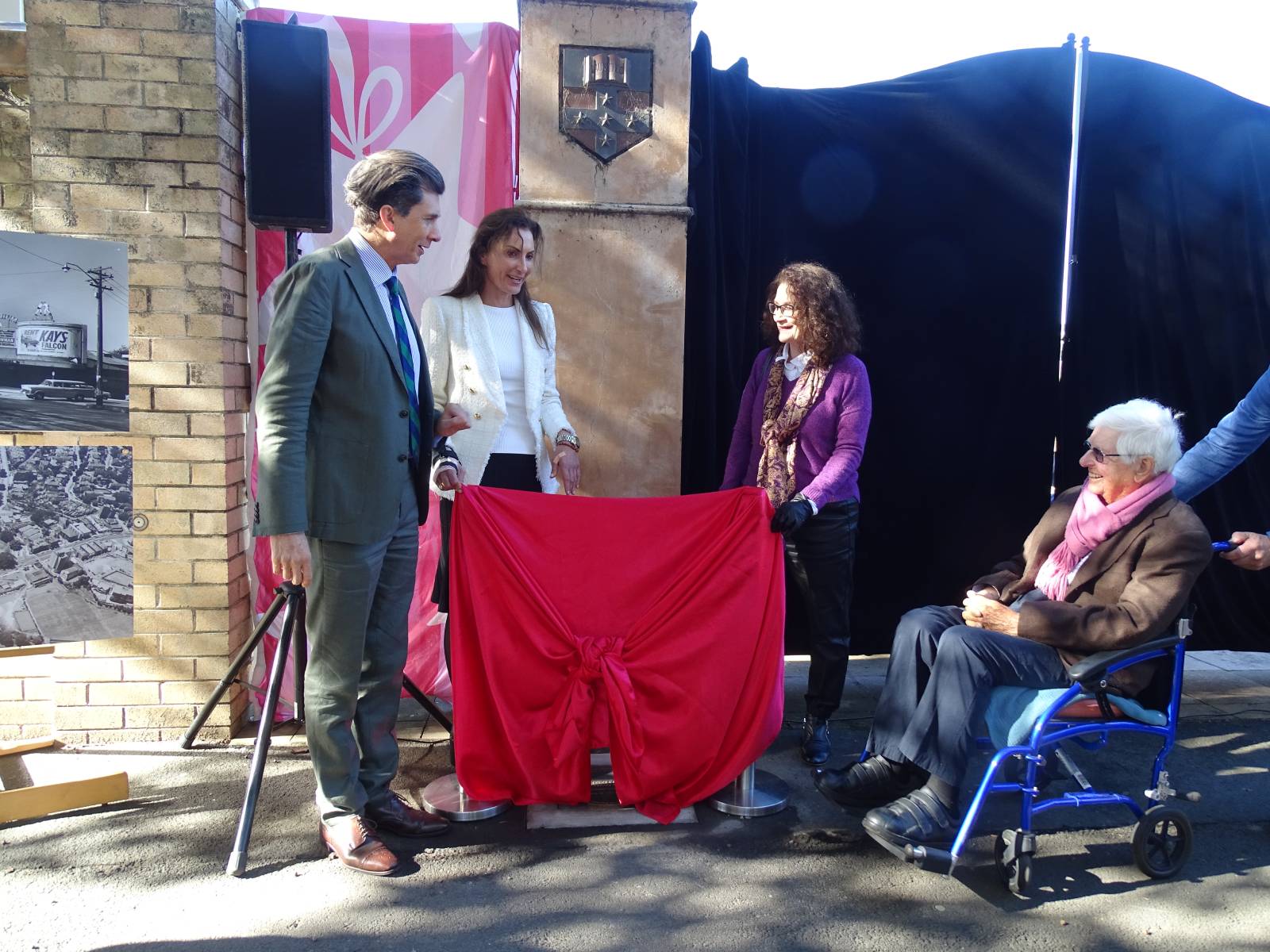
Plaque unveiling for The Beatles Concerts at the Sydney Stadium in June 1964. L-R Cr Anthony Marano, Mayor of Woollahra Cr Susan Wynne, guest speaker Dr Janis Lander, guest Bob Rogers OAM.
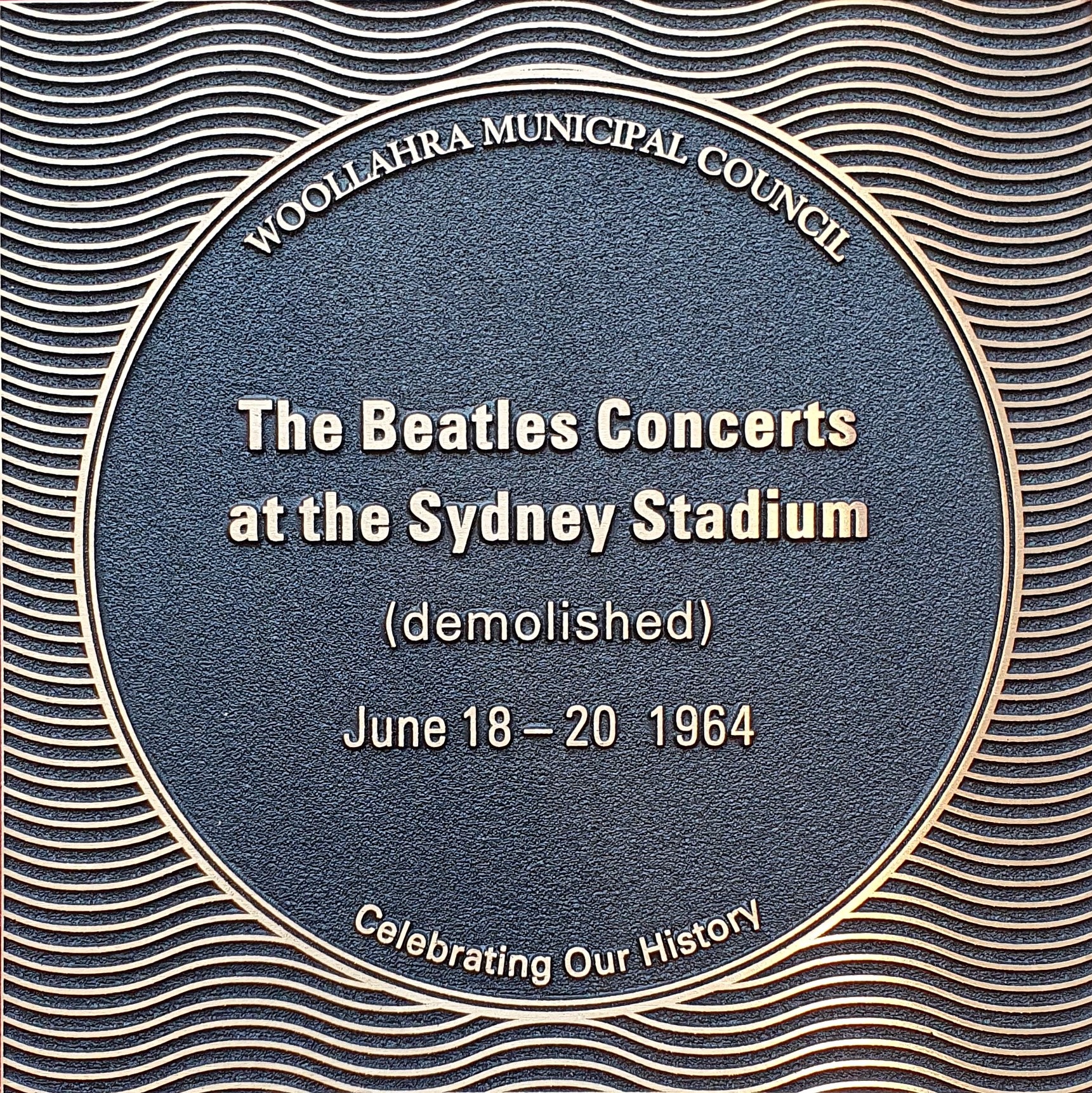
On 16 June 2021, a plaque commemorating The Beatles 1964 concerts in Sydney was unveiled near the site of the Sydney Stadium (demolished), the venue for the concerts on 18-20 June 1964.
The plaque is located on the footpath on Neild Avenue, near the corner of New South Head Road, Rushcutters Bay.
Watch the plaque unveiling here
Gallery
In June 1964, 'Beatlemania’ arrived in Sydney. The Beatles performed six concerts at the Sydney Stadiumi, Rushcutters Bay as part of a two week tour of Australia and New Zealand.
For all the charisma the four emitted, the real stars of the tour were the hundreds of thousands of ordinary people who screamed in public and viewed in private who were caught up by accident or intent in the joyful madness that swept the land...
Glenn A. Baker, The Beatles down under : the 1964 Australia and New Zealand tour, p. 7
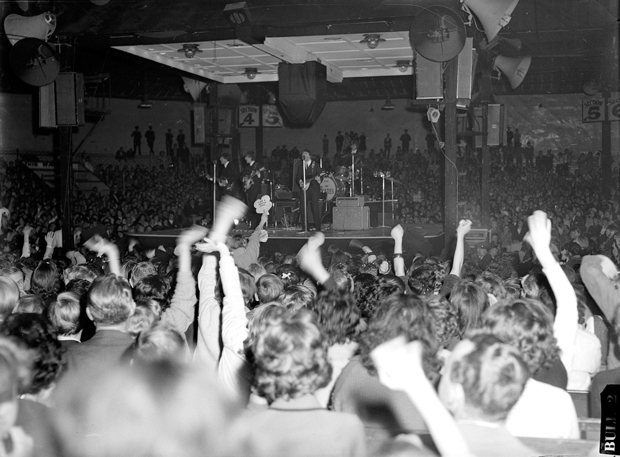
The Beatles concert at the Sydney Stadium, Rushcutters Bay, 18 June 1964. Photograph by Geoffrey Bull for the Sydney Morning Herald FXJ30238
‘Beatlemania’
In 1963, the British Press coined the term ‘Beatlemania’, describing
the relentless and seemingly hysterical response of that country’s teenagers to an indeterminate mixture of musical presence, public personality, and social significance that was projected by this pop group from the port city of Liverpool, whose fresh-faced exuberance and insouciant wit had endeared them to a substantial number of adult Britons as well
Jonathan Gould, Can't buy me love: the Beatles, Britain, and America, p. 1
The first Beatles single to be released in Australia was Please Please Me, issued on February 21, 1963 by EMI Records. The song was the second UK chart hit for the Beatles, making No. 2, but did not have the same success in Australia, the Beatles having been treated with a degree of indifference by the ‘painfully conservative Australian media and entertainment industry’.ii
This all changed in 1964, ‘the year that the 'Fab Four' took their potent aura to the world’.iii By then, the Beatles had notched up three UK No. 1 hits - From Me to You, She Loves You and I Want to Hold Your Hand.
In February 1964 a Pan American Airways jetliner at Kennedy Airport delivered the group to New York, beginning the Beatles' so-called ‘conquest’ of America, with a tour of the East Coast. They appeared twice on the Ed Sullivan Show, performing at the Washington Coliseum and Carnegie Hall in New York. Capitol Records had spent $50,000 promoting the group.
Filming for the movie A Hard Days Night began in the UK just 9 days after the Beatles return from the US. By this time, seven of Australia’s ‘top 40’ records were Beatles numbers - She Loves You stayed on the Australian charts for 42 weeks.
In June 1964, following a series of concerts in Holland and Denmark, the Beatles undertook a ‘Far Eastern Tour’, flying first to Hong Kong, ahead of two weeks of engagements in Australia and New Zealand.
Australia – 1964
"It all started on June 11 with a scheduled flight from Hong Kong’s Kai Tak that refuelled in Darwin where Australia witnessed the first manifestation of Beatlemania; at 2.35 on a winter’s morning 400 fans crowded the little terminal to see John Lennon, Paul McCartney, George Harrison and stand-in drummer Jimmy Nicol pass through Customs and Immigration".iv
‘Beatlemania’ had arrived ‘down under’ - it was the only time the Beatles would tour Australia. Author Jonathan Gould commented that "of all the tumultuous public receptions the group would experience, nothing before or after, in terms of scale, would compare with what awaited them in Australia".v
Incoming passenger cards record the arrival of the Beatles in Darwin on 11 June 1964, on BOAC Flight 801, listing their occupations as ‘Musician’ and length of stay 10 days.vi The Beatles’ onward flight touched down at Sydney’s Mascot airport just before 7:45am on Thursday 11 June 1964. Australian television, which was just eight years old, broadcast the event live to hundreds of thousands of viewers who watched the Beatles being ferried to the terminal on the back of a truck, in wind and drenching rain.vii
While in Sydney, The Beatles stayed at the Sheraton Hotel, Potts Point (40 Macleay Street, now apartments), taking over the top floor. The New York City Police department had given a warning to Australia, advising that ‘there will be chaos and confusion’ wherever the Beatles go. Hong Kong’s police chief had confidentially advised Sydney CIB that supporters (particularly young girls) would besiege their hotels, but that the Beatles themselves were amiable, and would ‘co-operate with police in the preservation of law and order’, spending most of the time, when not performing, in their hotel suites.viii
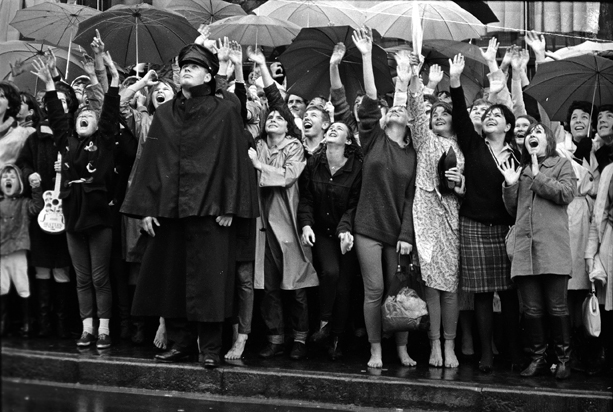
Fans outside the Chevron-Hilton, Potts Point wave to the Beatles at the Sheraton Hotel opposite, June 1964. Photograph by George Lipman for the Sydney Morning Herald. FXJ317113.
The Beatles' tour caused consternation among Australian police, aviation officials, hotel owners, parents and schools. Four of Sydney’s leading hotels (the Menzies, Chevron, Hotel Australia and Town House) had refused to book the Beatles. Eventually the owner of the small Sheraton Hotel in Macleay Street, Potts Point, offered to have them – it was a decision that would provide the hotel with free publicity for years to come. The Chevron manager wryly noted that they had originally refused the booking because of the expected crowds inside and outside the hotel - they got them anyway, but without the money or publicity, fans taking up vantage points outside the Chevron, hoping for a glimpse of the Beatles in the Sheraton Hotel opposite.
A polarisation of opinion regarding the presence of the Beatles was made obvious in the reaction of two Sydney girls schools. Miss P. Evans, headmistress of Ravenswood Methodist School banned students from having Beatles haircuts or carrying photos, stating that ‘We don’t want Ravenswood to be involved with those screaming mobs. I want to safeguard these children from something they do not understand’. On the other hand, Miss Betty Archdale, the indomitable principal of Abbotsleigh School for Girls at Wahroonga took a more enlightened view, allowing the girls to pin photos of the Beatles on their dormitory walls, and to watch the Beatles on TV, saying ‘I see no harm in the Beatles or the craze they have started’.ix
The first of the Beatles' twenty Australian shows was in Adelaide, followed by Melbourne, Sydney and finally Brisbane. The concerts usually consisted of a ten-song, half-hour set, performed to screaming audiences and padded out by four support acts. The show was compered by Alan Field, with performances in the first half by The Phantoms, who stayed on to back Johnny Devlin and Johnny Chester – the first half closed with Sounds Incorporated and the Beatles played the whole of the second half. There were two shows each night, one at 6pm and one at 8pm, and none on Sundays. Between the Sydney and Brisbane concerts there was an eight-day tour of New Zealand.x
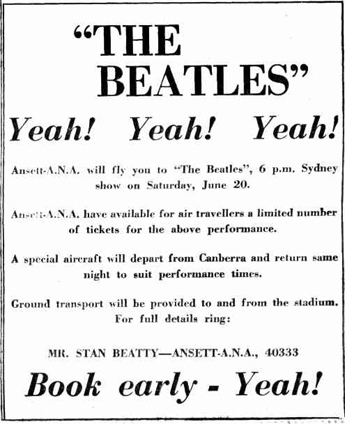
Advertising 15 April 1964, The Canberra Times, p. 41
“No single instance of Beatlemania throughout the globe ever came close to the intensity and sheer magnitude of the social upheaval which accompanied the 1964 Australian Beatles’ tour”
Glenn A. Baker, The Beatles down under, p. 7
The concerts - Sydney Stadium
Between 18-20 June 1964, The Beatles performed six concerts at the Sydney Stadium, Rushcutters Bay. Ticket prices ranged from 15s 6d to £1 17s 6d.xi
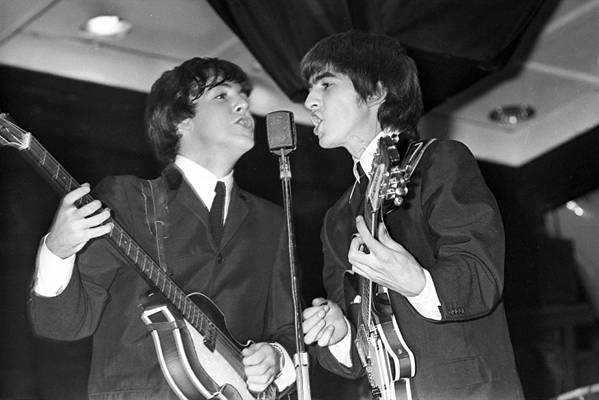
Paul McCartney and George Harrison at The Beatles concert, Sydney Stadium, Rushcutters Bay 18 June 1964. Photograph by George Lipman for the Sydney Morning Herald FXB1103765
Unlike the reception in Adelaide, where a large portion of the population had turned out, the initial response when the Beatles returned to Sydney was muted, with a relatively quiet crowd at the airport. Melbourne too had seen fairly chaotic scenes, with the Victorian police calling in the army and navy to assist.
The Beatles had by this time been reunited with their drummer, Ringo Starr, who had missed the first part of the tour due to a bad bout of tonsillitis, re-joining the Beatles in Melbourne. Stand-in drummer Jimmy Nicol quietly left Australia before the group returned to Sydney.
The first two Sydney concerts, on Thursday 18 June 1964, were only three quarters full. Promoter Kenn Brodziak was reported as saying “To this day, I’m not really sure why this happened. I tend to think that the sort of hysterical coverage which the Sydney press liked to run, frightened a lot of parents who thought there would be some kind of wild riot”. Following the first shows, when it was clear that no one would be trampled to death, the remaining four shows were packed.xii
A three minute newsreel in the National Film and Sound Archive (NFSA) features live footage of The Beatles and their fans during a concert in Sydney during their 1964 tour of Australia: The Beatles at Sydney Stadium, 1964. The curator notes that ‘Concert footage of popular acts was still in its infancy in the 1960s’ and ‘This professionally shot footage is the result of employing multiple cameras and stylish editing in post-production that effectively captures the phenomenon known as 'Beatlemania'’.
Terry Smith, Sports Journalist, devotes a chapter to ‘Beatlemania’ in his book The old tin shed, a history of the Sydney Stadium. He attended the first Beatles concert in Sydney - tickets being one of the perks of being the Sydney Morning Herald’s boxing writer:
‘None of us who packed into the Stadium for the first Sydney concert…will ever forget it. Onto the revolving stage trotted The Beatles through a phalanx of uniformed police and security men’…‘It was absolute bedlam. The screams hit the tin roof and echoed round the stadium to create a noise level claimed by a sound expert to exceed that of a Boeing 707 jet in full flight’.
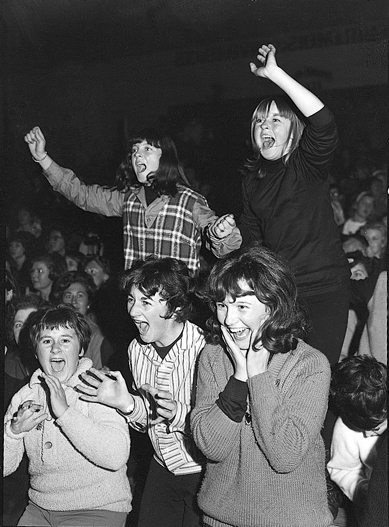
Screaming Beatles fans at their stadium concert in Sydney, 18 June 1964. Photograph by Noel Stubbs for the Sydney Morning Herald. FXJ313125.
Annette Dixon, who was thirteen years old when she attended one of the concerts at the Sydney Stadium in 1964, shared her reminisences of the event:
I saw The Beatles then [in 1964]. My mum saved money to buy my ticket and our neighbour did the same for their daughter Sandra Hanmer. Her elder sister took us. We sat in what was called “the bleachers” … we screamed with everyone else - then we followed the crowd up to their [The Beatles] hotel Sheraton. They came out onto the roof of their hotel and threw a bucket of water out into the crowd. We gladly got wet. So, so long ago for us two 13 year olds.
Annette Dixon
Newspaper reports of the Sydney concerts ranged ‘from the puerile to the refreshingly serious’.xiii Craig McGregor, of the Sydney Morning Herald, gave the ‘sole serious appraisal of the performance’ writing:
“The Beatles showed themselves last night to be every bit as polished, as exciting and engaging in person as they are on records – and what is more surprising a great deal gentler. This quality is somewhat unexpected in a Liverpool beat band whose music is raucous R&B, only slightly mellowed by a native English interest in harmony and musical colour …It was unexpected to find them singing numbers like ‘All My Loving’ and ‘I Saw Her Standing There’ with such warmth and romanticism…Yet the Beatles were, without a doubt the wildest, swingiest and ravingest quartet of pop musicians to hit the stadium since Little Richard.”
Most other reporters focused on the noise and hysteria of the fans. Ron Ford, of the Sun, had reported:
“It hit the tin roof of the Stadium and thundered round the empty bleachers: She was Just Sev! En! Teen!. The first real live Beatle sound in Sydney. And that’s all they got out before the shrieks took over for thirty minutes solid. It was hard to believe that these four frail and largely lifeless looking lads could whip up such a scene. Round and round went the baffled Beatles [a reference to the Stadium’s revolving stage] with a ‘stop the stage I want to get off’ look on their faces.”
After the final two concerts the Sunday Telegraph reported that “Screaming teenagers last night turned the Beatles’ last two concerts into near riot” and the Sun-Herald noted that “Thousands of girls under sixteen who occupied the most expensive seats seem to be in a state of delirium …”
All three Sunday newspapers carried extensive reviews of the fifth and sixth concerts on Saturday night – the first to have ‘house-full’ signs up before the headliners hit the stage. The late show was the balltearer of the tour and even the out of touch reviewers managed to realise it ..
Glenn A. Baker, The Beatles down under, p. 101
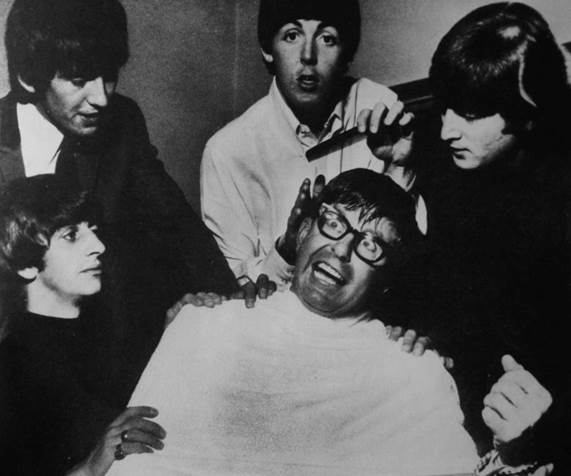
Sydney DJ and radio broadcaster Bob Rogers OAM, pictured with The Beatles when he was on tour with them in 1964. Image: Private collection
“From the beginning there were several attributes that distinguished the Beatles from anything that had happened in popular music before. The first was their nationality. Since the term had been first coined in the 1920s, the very concept of a ‘superstar’ had become synonymous with celebrity entertainment culture of the US. The Beatles in 1964 were the first unmistakably non-American performers to achieve the status of superstars on an international scale ..spearheading a British invasion of the American music scene.
Jonathan Gould, Can't buy me love, p. 9
The Beatles grew up in Liverpool, one of the British seaports serving North America, which picked up the new rhythm and blues releases from sailors before the rest of Britain caught on.
In all but name, the Beatles began with the friendship of John Lennon and Paul McCartney who met in July 1957 at a garden fete at St Peter’s Church, Woolton.xivJohn Lennon’s band, the Quarrymen, played a mix of rock & roll and skiffle, which had jazz, blues and folk influences. Shortly afterwards Paul McCartney joined the band as rhythm guitarist. By the summer of 1958, the nucleus of the future Beatles, - Lennon, McCartney and Harrison – was formed …not so much a band as a small circle of musical friends xv, including John’s friend Stuart Sutcliffe. They adopted the name the Beatles in August 1960, recruiting drummer Pete Best before a series of engagements in Hamburg. Stuart Sutcliffe left the Beatles in 1961 to pursue a career in art and Ringo Starr replaced Pete Best in August 1962, completing the line-up most usually associated with the Beatles – John, Paul, George and Ringo.
In November 1961, Brian Epstein heard the Beatles play at the Cavern Club in Liverpool, and was immediately taken with them. Over the next few months he courted the group, becoming their manager in 1962.
“The years of [the Beatles] story coincided with a period of rampant social and cultural change in Britain and America, and throughout the industrialised world” … ‘it culminated during the 1960s with the emergence of London as a world capital of pop culture, ruled by an unruly elite of ‘war babies’ who were bent on taking their country’s new climate of expressive freedom to once unimaginable extremes. The Beatles began as creatures of this new social and cultural milieu; they wound up serving as the most prominent symbols of it for people all over the world”.
Jonathan Gould, Can't buy me love, p. 14
In 1965 the British Prime Minister’s office, under newly elected Douglas Wilson, a fellow northerner, announced that the Beatles were to be appointed as Member of the Order of the British Empire (MBE). Surprisingly, the award cited their contribution to commerce, not the arts, with some estimates putting the Beatles records sales at more than 150 million records worldwide by August 1965xvi. A growth in Britain’s fashion, entertainment and tourism industries was also attributed to a rising ‘pop Anglophilia’ in the US, Europe and Asia.
The Beatles were inducted into the Rock and Roll Hall of Fame in 1988 by Mick Jagger.xvii
John Winston Lennon MBE - 9 October 1940 – 8 December 1980
John Winston Lennon gained worldwide recognition as the founder, co-lead vocalist, and rhythm guitarist for the Beatles - his songwriting partnership with fellow Beatle Paul McCartney recognized as one of the most successful in the industry.
In 1969, he started the Plastic Ono Band with his second wife, Yoko Ono. After the Beatles disbanded in 1970, Lennon continued with a solo career releasing the album Imagine. ‘Following the release of Imagine, Lennon’s nonmusical activities and personal life tended to overshadow his career as a recording artist’ - John Lennon and Yoko Ono moved to New York city in 1971 where they ‘immersed themselves in various left-wing political causes’xviii, and were critical of US involvement in the Vietnam War, creating issues with John’s residency visa in 1973. Following the birth of his son Sean in 1975, John Lennon withdrew from the public and devoted the rest of the 1970s to his family.
Along with the other Beatles, John Lennon was appointed a Member of the Order of the British Empire (MBE) in 1965, but returned his medal in November 1969, with an accompanying letter stating: ‘I am returning this MBE in protest against Britain's involvement in the Nigeria-Biafra thing, against our support of America in Vietnam and against Cold Turkey slipping down the charts.’
John Lennon was tragically shot and killed outside his Manhattan apartment building in 1980 by a Beatles fan. He was inducted into the Rock and Roll Hall of Fame (posthumously) as member of the Beatles in 1988, and as a solo artist in 1994.
Paul McCartney (Sir James Paul McCartney CH MBE) 18 June 1942 -
Paul McCartney gained his initial international fame as co-lead vocalist and bass guitar player for the Beatles. Born in Liverpool, he attended the Liverpool Institute High School (a grammar school), where he befriended George Harrison. Paul McCartney’s songwriting partnership with John Lennon produced a large portion of the Beatles catalogue – both wrote lyrics as well as music – but many other well-known hits are credited to Paul McCartney, including: And I Love Her (1964), Yesterday (1965), Eleanor Rigby (1966) and Blackbird (1968). After the Beatles disbanded in 1970, Paul McCartney pursued a solo career, forming the band Wings with his first wife, Linda, and Denny Laine (formerly of the Moody Blues) – the group achieved a number of hit singles and albums during the 1970s – including Mull of Kintyre, a record selling single released in 1977. Since the 1980s he has toured and performed as a solo artist. Paul McCartney’s interests beyond music include a commitment to a number of international causes and charities including animal rights and vegetarianism.
In an essay for the Rock and Roll Hall of Fame - Paul McCartney was inducted as a solo artist in 1999 – teacher, journalist and music critic for the New York Times, Allan Kozinn, says of Paul McCartney:
“The fact is, his salient feature as an artist is not, as some might assert, the ability to spin out a melody at the drop of a hat. What really drives him, as both composer and performer, is an unquenchable musical curiosity and the urge to constantly create.’ ‘He could, of course, leave the public stage secure in the knowledge that his existing work will continue to thrill people in great numbers, and with his place in musical history assured many times over. But for someone with McCartney’s creativity and drive, stopping would be incomprehensibly out of character”.xix
Paul McCartney received a knighthood in 1997 for services to music in the British and in the 2018 Queen’s Birthday Honours list he was awarded a Companion of Honour (CH) for his ‘lasting contribution to music in the UK and Worldwide’ xx.
George Harrison MBE 25 February 1943 - 29 November 2001
George Harrison was born on 25 February 1943 in the family home in Wavertree, Liverpool. He joined the Beatles in 1958, and was only 17 when the group went to Hamburg in 1960, achieving international fame as the lead guitarist for the Beatles. By 1965 George Harrison had developed an interest in folk rock, including the music of Bob Dylan and the Byrds, and Indian Classical music – these influences can be found in some of the Beatles later work such as Norwegian Wood, in which he used the sitar. Although the majority of the band’s songs were Lennon- McCartney compositions, George Harrison was also a songwriter – his work included well known Beatles songs such as While My Guitar Gently Weeps and Here Comes the Sun.
After the band broke up in 1970, Harrison released a triple album All Things Must Pass, which contained the hit single My Sweet Lord. He also organised a 1971 Concert for Bangladesh with Indian musician Ravi Shankar, and founded Dark Horse Records in 1974. George Harrison continued to perform as a guest guitarist and collaborated with Bob Dylan, Eric Clapton, Ringo Starr and others.
George was a Rock and Roll Hall of Fame inductee in 2004 (posthumously) for his solo career. When George Harrison died from lung cancer in 2001 at the age of 58, his remains were cremated and the ashes were scattered according to Hindu tradition in a private ceremony in India.
Ringo Starr (Sir Richard Starkey MBE) 7 July 1940 -
Best known as the Beatles’ drummer, Ringo Starr, Richard Starkey was born in Liverpool in July 1940, growing up in a run-down working class area of the city known as Dingle. Despite a childhood beset by medical issues, which impacted his education, Ringo ‘had decided flair’ - he was the ‘master of the Liverpudlian deadpan, the slow Liverpudlian double-take, and the curt Liverpudlian retort’ - and ‘from the moment he joined, the Beatles became almost unimaginable without him’ xxi. He sang vocals on a number of well-known songs, including Yellow Submarine and With a Little Help from My Friends, and wrote or co-wrote others, including Octopuses Garden.
Prior to joining the Beatles, Ringo co-founded the Eddie Clayton Skiffle Group (1957), later joining Rory Storm and the Hurricanes which became a popular Merseyside band. He left the Hurricanes when he was asked to join the Beatles in August 1962. Ringo has had a successful career in music and film following the Beatles break up, narrating the first two series of the children's television programme Thomas & Friends, also touring with Ringo Starr & His All-Starr Band.
In the testimonial on the Classic Drummer Hall of Fame, Ringo is said to have been the inspiration for many professional drummers.
"More than any other drummer, Ringo Starr changed my life. The impact and memory of that band on Ed Sullivan Show in 1964 will never leave me. I can still see Ringo in the back moving that beat with his whole body, his right hand swinging off his sock cymbal while his left hand pounds the snare. He was fantastic, but I think what got to me the most was his smile. I knew he was having the time of his life."
Max Weinberg xxii
Ringo was inducted into the Rock and Roll Hall of Fame as a solo artist (2015)xxiii and was appointed a Knight Bachelor for services to music in the 2018 UK New Year Honours List.xxiv
The promoter - Kenn (Kenneth Leo) Brodziak 31 May 1913 – 3 June 1999
“Kenn Brodziak’s presentation of the Fab Four from Liverpool, still cited as the greatest entertainment coup Australia has ever witnessed, was not the result of great vision or adept negotiation. It was, in fact, a classic piece of accidental good luck”.
Glenn A. Baker, The Beatles Down Under
The Beatles tour was booked in July 1963 by Australian promoter Kenn Brodziak, Managing Director of Aztec Services Pty, who co-promoted international acts with Richard (Dick) Lean, Managing Director of Stadiums Ltd, managers of the Sydney Stadium. Brodziak had booked the Beatles - well before ‘Beatlemania’ became a worldwide phenomenon - as a supporting act for the modest sum of £1000 a week (accommodation not included)xxv. It was a verbal contract, not finalised until January 1964 when Epstein, the Beatles manager, honoured the original agreement to tour Australia, albeit asking for a slight increase to £1500 per week – it was still well short of the going rate. According to Glenn A. Baker, ‘at ten times that it would still have been an outrageous steal’.
“The Australian promoter, Kenn Brodziak, had negotiated the tour in July 1963, before the hysteria had begun in England. By the time they arrived here, they were the biggest musical act on the planet and Brodziak had his hands on the most successful undertaking in Australian show business history. In the intervening 11 months, the English press had coined the word ‘Beatlemania’ to describe the frenzied screaming of fans. This phenomenon had created a huge international demand for records, merchandise and concert tickets”.
Peter Cox, The Beatles in Australia Essay, MAAS, 5 April 2018
Sponsors negotiated for the tour included the British Motor Company, who provided Austin Princess and Morris 1100 cars for the entourage, and Ansett, who outbid TAA by providing air transport for free.xxvi TAA did however manage to create some publicity of their own - the Beatles had arrived in Sydney in the middle of a storm, and agreed to tour the fans enclosure in an open truck despite the weather. As the group disembarked the aircraft, a quick thinking TAA executive handed each of them a large umbrella, boldly marked with TAA lettering, and the iconic images of the Beatles in their capes and TAA umbrellas went round the world.
Brodziak was an influential figure in the history of promotion in Australia, bringing the stage show Godspell to Australia, as well as touring Cliff Richard and the Shadows, Bob Dylan, Marlene Dietrich, The Vienna Boy’s Choir, and Peter Paul and Mary, amongst others.
The Sydney Stadium was initially conceived as a temporary structure, constructed by promoter Hugh D. McIntosh for the World Heavyweight Boxing title fight between Canadian Tommy Burns and Australian Bill Squires in August 1908. In December of the same year, the Stadium was the setting for another World Heavyweight title bout, when challenger Jack Johnson defeated Tommy Burns becoming the first African-American to win the title.xxvii
In 1912 the Sydney Stadium was roofed over and enlarged to a design by architect T. P. Sampsonxxviii, becoming a more permanent structure, albeit of wood and galvanised iron, affectionately known as the 'old tin shed'. The roof was built in the form of an octagon and it was to become an iconic Sydney boxing and entertainment venue, hosting numerous boxing bouts and playing host to The Beatles, Louis Armstrong, Frank Sinatra, Buddy Holly, and The Rolling Stones, as well as Symphony orchestras and religious evangelists. Boxing promoter and stadium manager, Henry Lawrence (Harry) Miller managed the Stadium for 33 years.
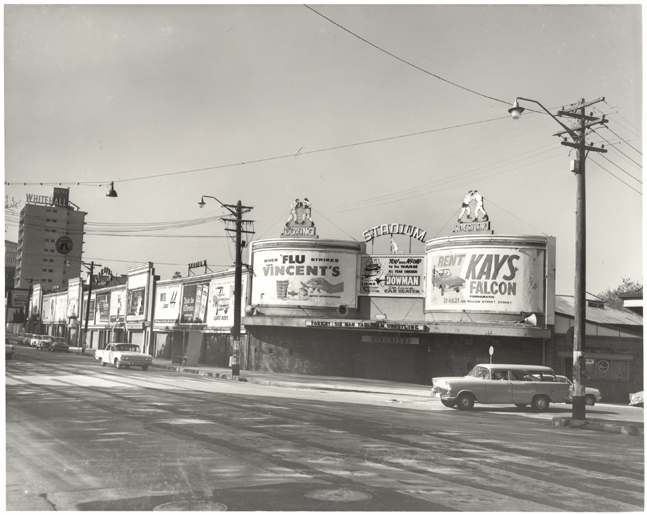
Sydney Stadium [from] the corner of Neild Avenue and New South Head Road, Rushcutters Bay, 1965 / Ern McQuillan. National Library of Australia. nla.obj-137094253
The sound systems available in all the venues for the Beatles concerts were fairly basic – essentially the same facilities used for wrestling, boxing and revivalist meetings. Glenn A. Baker quotes Ron Blackmore, who later supervised PAs for the Rolling Stones 1973 concerts, who explained
“there was one amplifier, of about 100-150 watts, into which ran an average of 8 microphones.. there was no mixer : the singer balanced the sound by moving back and forward on the mic. There was a volume knob and a tone knob and that was it. All this was usually locked away in a back room somewhere, although at the Sydney Stadium it was under the stage. Out front it was even worse. At the Stadium, there was a cluster of tin AWA horns on each of four posts which were aimed at the four seating sections. This was what the Beatles’ voices were carried through, though it wasn’t altogether as bad as it sounds. Groups in the sixties learned their harmonies so well that they could be put in separate rooms and still keep in time with the other guys. The Beatles harmonies weren’t bad at all”.xxix
Dressing rooms at all the concert venues were similarly primitive - draughty wooden boxes, reeking of sweat and liniment - the only exception was the Sydney Stadium where Dawn Miller, wife of Sydney Stadium manager Harry Miller, had redecorated backstage prior to the concerts. Walls were painted, two lounge suites and coffee table installed and curtains hung.
There was a suggestion that this may have been done to divert the Beatles’ attention away from the ‘curse of the Sydney Stadium – the revolving stage’ which was built on top of the boxing ring. Ron Blackmore explained: “Because the microphone cables ran up a centre pole, the stage couldn’t go around continually in one direction. It went one turn and then a little man by side-stage with a lever sent it back the other way so that the cables could untangle”.xxx Perhaps this was just as well – in 1954, in the middle of jazz trumpeter Louis Armstrong’s first Australian performance, dense smoke billowed from under the stage, caused by the electric motor which drove the revolving stage becoming red-hot and threatening to set the stage alight.xxxi
The Sydney Stadium was demolished in 1970 to make way for the Eastern Suburbs Railway.
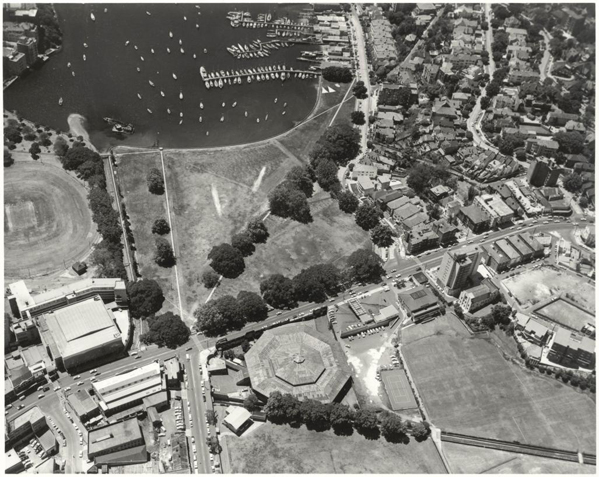
Aerial view of Sydney Stadium at Rushcutters Bay, Ern McQuillan, 1968. National Library of Australia vn3562173 © Estate of the artist
Significance
In 2013 the Museum of Applied Arts and Sciences (the Powerhouse Museum) mounted an exhibition ‘The Beatles in Australia’ chronicling the tour’s lasting impact on Australian music and culture.
“The eruption of Beatlemania in Australia was more intense than anywhere in the world. For thirteen days in 1964 the nation was held in a kind of euphoria, captivated by the talent, the songs and the charm of the Fab Four on their concert tour”
The Beatles in Australia, MAAS exhibition 2013-14
Terry Smith quotes rock music journalist and commentator Glenn A. Bakerxxxii, on why The Beatles caused such an upheaval in Australia:
“The Beatles were a sign from above, a skewer to lance the boil of stifling traditionalism. They had the power to link us, a colonial backwater, to a big wide world of fads and fashions and uninhibited excitement. The Beatles, their presence and their lingering influence, became a catalyst for the suppressed frustrations of kids who had begun to realise that unquestioned obedience to anyone older was no longer a sacred law. It liberated young Australians…”
Peter Cox, who curated the MAAS exhibition, observed in his 2018 essay, ‘The Beatles in Australia’, that "The tour was a major event for Australia in the 1960s. It kicked into gear that tumultuous decade, sparking an exciting period in music and culture". He noted that The Beatles visit to Australia influenced a generation of Australians to travel to the UK at a time when London was becoming 'the font of youth fashion and popular culture'. The Beatles tour also paved the way for visits by other English groups. "This ‘British invasion’ caused a sudden and dramatic shift in Australian music. A new generation of local groups, most made up of recent migrants, including The Easybeats, The Bee Gees, Billy Thorpe & the Aztecs, MPD Ltd and The Twilights, led an Australian ‘beat boom’ in the mid-1960s”.
The Beatles had arrived in Australia at a time when ‘overseas travel was prohibitively expensive, and so were international phone calls’ - not everyone owned a television. The Beatles concerts provided a link to the emerging counter-culture of the 1960s and a ‘once in a lifetime celebration of youthful rebellion’xxxiii for thousands of Sydney-siders.
Baker, Glenn A. The Beatles down under : the 1964 Australia and New Zealand tour. Glebe : NSW, 1982
Coupe, Stuart. The promoters : inside stories from the Australian rock industry. Sydney : Hodder Headline Australia, 2003.
Gould, Jonathan, Can't buy me love : the Beatles, Britain, and America. New York : Harmony Books, c2007.
Hayward, Mark. The Beatles in Australia. Sydney : New Holland Publishers (Australia) Pty Ltd, 2005.
Smith, Terry, The old tin shed : Sydney Stadium 1908-1970, North Sydney, N.S.W. : Eric Spilsted Publishing, c1999. [Chapter 8 Beatlemania]
https://maas.museum/event/the-beatles-in-australia/
https://maas.museum/the-beatles-in-australia-essay/
https://dictionaryofsydney.org/entry/the_beatles_in_sydney
Footnotes
i The Sydney Stadium, known as 'The Tin Shed', was an iconic large-capacity boxing and concert venue that stood on the corner of New South Head Road and Neild Avenue, Rushcutters Bay, until it was demolished in 1970 to make way for the Eastern Suburbs Railway.
ii Glenn A. Baker The Beatles down under : the 1964 Australia and New Zealand tour, Glebe : NSW, 1982, p. 11
iii Baker, Glenn A. p. 12
ivhttps://www.heraldsun.com.au/news/victoria/the-beatles-in-australia-50-years-on-how-four-days-changed-melbourne/news-story/5de26eafc62b02396670d7aaf9615f59.
v Gould, Jonathan, Can't buy me love : the Beatles, Britain, and America. New York : Harmony Books, c2007 p. 21
vi NAA Incoming Passenger Cards NAA: A1225, 9-12 JUNE 1964 NSW BEATLES
viihttps://www.smh.com.au/entertainment/the-beatles-let-it-be-in-australia-1964-20140606-zrvui.html
viii Baker, Glenn A., p. 24
ix Baker, Glenn A., p. 14
xhttps://maas.museum/the-beatles-in-australia-essay/
xi Average Weekly Male earnings in NSW for 1965-1966 as reported by the ABS were about $58.00 (£27.50) https://www.abs.gov.au/statistics/labour/earnings-and-work-hours/average-weekly-earnings-australia
xii Baker, Glenn A., p. 72
xiii Baker, Glenn A., p. 100
xiv Gould, Jonathan, p. 26
xv Gould, Jonathan, p. 57
xvi Gould, Jonathan, p. 273
xviihttps://www.rockhall.com/inductees/beatles
xviii Gould, Jonathan, p. 602
xixhttps://www.rockhall.com/inductees/paul-mccartney
xx A tweet from the Royal Family’s official Twitter page read: “Congratulations Sir @PaulMcCartney who has been made a #CompanionofHonour at Buckingham Palace today for his lasting contribution to music in the UK and Worldwide.”
xxi Gould, Jonathan, p. 127
xxiihttps://www.classicdrummerhalloffame.com/ringo-starr
xxiiihttps://www.rockhall.com/inductees/ringo-starr
xxivhttps://www.gov.uk/government/news/the-new-years-honours-list-2018 and https://www.bbc.com/news/entertainment-arts-43472196
xxv Baker, Glenn A., p. 11
xxvi Coupe, Stuart. The promoters : inside stories from the Australian rock industry. Sydney : Hodder Headline Australia, 2003. Part 2: The Beatles and Brodziak
xxvii In 2019, Woollahra Council unveiled a plaque commemorating the December 1908 bout
xxviii No title (1912, July 29). Construction : Weekly Supplement to Building (Sydney, NSW : 1909 - 1914), p. 8. http://nla.gov.au/nla.news-article234759831
xxix Ron Blackmore as quoted in Baker, Glenn A., p. 94
xxx Ron Blackmore as quoted in Baker, Glenn A., p. 96
xxxi Louis Armstrong And Band Get A Hot Reception (1954, October 28). The Sydney Morning Herald (NSW : 1842 - 1954), p. 1. http://nla.gov.au/nla.news-article18448805
xxxii From Glenn A. Baker, Places and Barely Human Race’, 1995, as quoted in Smith, Terry, The old tin shed, p 101
xxxiii Robin Gerster and Jan Bassett, Seizures of Youth, The Sixties and Australia. South Yarra, Victoria: Hyland House, 1991, p 4, as quoted in Dictionary of Sydney - The Beatles in Sydney
New plaques are added based on nominations from the community, which are then assessed against selection criteria and researched by a Local History Librarian.
Find out more and nominate a person or event for a plaque.